What Your Clutter Is Trying to Tell You
Why is decluttering just so hard? The authors of New Minimalism reveal how your emotional style relates to the possessions you keep—and how you can finally get past it.
By Cary Telander Fortin and Kyle Louise Quilici
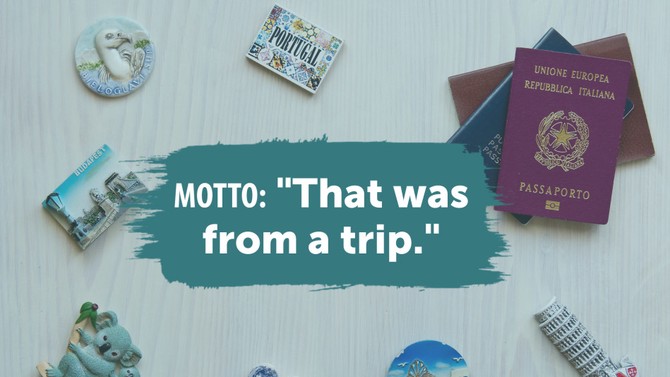
Photo: iStock
Archetype #1: Connected
SHADOW SIDE OF CONNECTED: Clinging
BLOCK: Sentimentality
HAS A HARD TIME LETTING GO OF: Gifts, handwritten cards, travel souvenirs, ticket stubs
The Connected archetype has an emotional, relational, and impassioned way of approaching the world. These people treasure family, friendships, and partnerships above all else. They love to make those they care about feel good. Connected types tend to be wonderful hosts, the people you can rely on to throw a great party, send you a birthday card, or remember that important date on the calendar.
Connected types dwell in the present; they are focused on whoever is in front of them in the moment. They are exceptional listeners who try their best to offer thoughtful and compassionate advice. Connected types act from a place of interrelatedness, bestowing a reverence upon the people and things in their lives.
Connected people will venture toward the shadow side of their emotional style when they confuse the physical object with the actual relationship or experience itself. They feel that if they give up the objects related to a relationship, they are devaluing the relationship; they’re afraid they will lose important people or memories if they don’t hold on to all the evidence.
The main thing blocking Connected types from releasing items is sentimentality. If an object is in any way linked to a relationship—such as a gift or a note, or a photograph or a souvenir from a shared experience—Clinging people will hold on to it even if they do not use or enjoy it.
Tool for Moving from Clinging Back to Connected
First, remember that your memories and experiences are separate from your possessions. We like to use the phrase “Collect memories, not things” to sum up the idea that it’s not actually the objects we love but the memories they reference. Start by first freeing yourself of the obligation to memorialize every event from your past with a physical memento. Trust that you will naturally recall specific memories or experiences as you continue to live out your days.
When deciding to part with an item of sentimental value, take a moment to “bless and release” it. Rather than dumping a broken travel token in the trash or throwing a gifted sweater in the donation bin, give yourself a moment to honor the item. Appreciate it and the person or circumstance that brought it into your life. Hug the item (or smell it or pat it) one last time, and say aloud an expression of gratitude, like “Thank you, ugly Christmas sweater. You came into my life as such a thoughtful gift, and I release you to keep someone else warm and happy this winter.”
BLOCK: Sentimentality
HAS A HARD TIME LETTING GO OF: Gifts, handwritten cards, travel souvenirs, ticket stubs
The Connected archetype has an emotional, relational, and impassioned way of approaching the world. These people treasure family, friendships, and partnerships above all else. They love to make those they care about feel good. Connected types tend to be wonderful hosts, the people you can rely on to throw a great party, send you a birthday card, or remember that important date on the calendar.
Connected types dwell in the present; they are focused on whoever is in front of them in the moment. They are exceptional listeners who try their best to offer thoughtful and compassionate advice. Connected types act from a place of interrelatedness, bestowing a reverence upon the people and things in their lives.
Connected people will venture toward the shadow side of their emotional style when they confuse the physical object with the actual relationship or experience itself. They feel that if they give up the objects related to a relationship, they are devaluing the relationship; they’re afraid they will lose important people or memories if they don’t hold on to all the evidence.
The main thing blocking Connected types from releasing items is sentimentality. If an object is in any way linked to a relationship—such as a gift or a note, or a photograph or a souvenir from a shared experience—Clinging people will hold on to it even if they do not use or enjoy it.
Tool for Moving from Clinging Back to Connected
First, remember that your memories and experiences are separate from your possessions. We like to use the phrase “Collect memories, not things” to sum up the idea that it’s not actually the objects we love but the memories they reference. Start by first freeing yourself of the obligation to memorialize every event from your past with a physical memento. Trust that you will naturally recall specific memories or experiences as you continue to live out your days.
When deciding to part with an item of sentimental value, take a moment to “bless and release” it. Rather than dumping a broken travel token in the trash or throwing a gifted sweater in the donation bin, give yourself a moment to honor the item. Appreciate it and the person or circumstance that brought it into your life. Hug the item (or smell it or pat it) one last time, and say aloud an expression of gratitude, like “Thank you, ugly Christmas sweater. You came into my life as such a thoughtful gift, and I release you to keep someone else warm and happy this winter.”
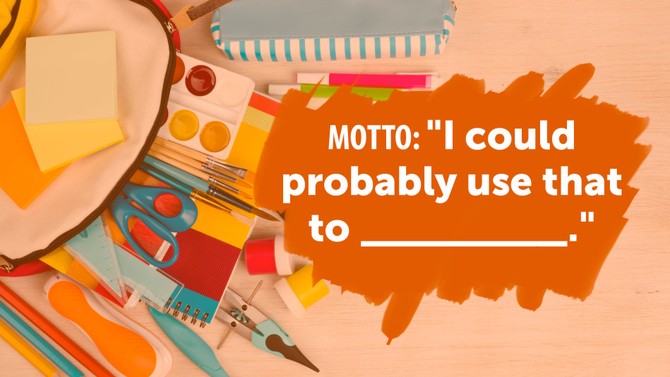
Photo: iStock
Archetype #2: Practical
SHADOW SIDE OF PRACTICAL: Limited
BLOCK: Usefulness
HAS A HARD TIME LETTING GO OF: Art supplies, craft supplies, electrical cords, old nails and screws, scrap materials
The Practical archetype operates from the logical hub of the mind. It is a data-driven, methodical, and factual way of approaching the world. The Practical archetype comes into play when there is a task at hand, an actionable item, an objective to be met, or a question that needs to be answered. These people are often engineering wizards: deductive, strategic, and pragmatic. They creatively find ways to improve a scenario, figure out the most efficient route to a destination, or make extra space in a dishwasher that is already full. This archetype always reminds us of our childhood hero, MacGyver.
When operating from the shadow side, Practical types are Limited, unaware of the latent effect their things have on them. They are unaware of or able to ignore how a cluttered space negatively impacts them and, more often, how their space affects other people. They can often be rigid in their opinions, seeing only one truth according to the data at hand. Though it may be practical to hold on to things that might be useful in a hypothetical future, it ends up limiting space for their present day needs and life.
Limited types also have a narrow understanding of use; they consider only the absolute usefulness of an item, not taking into account an item’s actual usefulness to them in their present lives. They can easily compartmentalize their chaotic, disordered homes to lead otherwise highly functioning, orderly lives.
The central idea blocking Limited types from releasing items is usefulness. If an object has a perceived use—for any person in any circumstance—practical people will hold on to it even if it is not useful to them.
Tool for Moving from Limited Back to Practical
When you’re operating from the Limited mind-set, you’ll notice that any and all “useful” items get a free pass to stay in your home. The problem here is that there are millions of things in the world that have utility, and if you want a clutter-free home, you’re going to have to drastically increase your standards for what is allowed to stay. The key here is to remove hypothetical situations from your reasoning to keep an item. Notice if you start with phrases like “I might” or “I could” when thinking about an item. Instead, focus on the present moment and your current needs. Even if an item is in theory useful, do you need it right now? If not, err on the side of donating it—someone else will certainly use and enjoy it.
Before decluttering, it is helpful for Practical types to identify organizations that are willing and able to accept their donations of useful items so that they won’t be discarded.
BLOCK: Usefulness
HAS A HARD TIME LETTING GO OF: Art supplies, craft supplies, electrical cords, old nails and screws, scrap materials
The Practical archetype operates from the logical hub of the mind. It is a data-driven, methodical, and factual way of approaching the world. The Practical archetype comes into play when there is a task at hand, an actionable item, an objective to be met, or a question that needs to be answered. These people are often engineering wizards: deductive, strategic, and pragmatic. They creatively find ways to improve a scenario, figure out the most efficient route to a destination, or make extra space in a dishwasher that is already full. This archetype always reminds us of our childhood hero, MacGyver.
When operating from the shadow side, Practical types are Limited, unaware of the latent effect their things have on them. They are unaware of or able to ignore how a cluttered space negatively impacts them and, more often, how their space affects other people. They can often be rigid in their opinions, seeing only one truth according to the data at hand. Though it may be practical to hold on to things that might be useful in a hypothetical future, it ends up limiting space for their present day needs and life.
Limited types also have a narrow understanding of use; they consider only the absolute usefulness of an item, not taking into account an item’s actual usefulness to them in their present lives. They can easily compartmentalize their chaotic, disordered homes to lead otherwise highly functioning, orderly lives.
The central idea blocking Limited types from releasing items is usefulness. If an object has a perceived use—for any person in any circumstance—practical people will hold on to it even if it is not useful to them.
Tool for Moving from Limited Back to Practical
When you’re operating from the Limited mind-set, you’ll notice that any and all “useful” items get a free pass to stay in your home. The problem here is that there are millions of things in the world that have utility, and if you want a clutter-free home, you’re going to have to drastically increase your standards for what is allowed to stay. The key here is to remove hypothetical situations from your reasoning to keep an item. Notice if you start with phrases like “I might” or “I could” when thinking about an item. Instead, focus on the present moment and your current needs. Even if an item is in theory useful, do you need it right now? If not, err on the side of donating it—someone else will certainly use and enjoy it.
Before decluttering, it is helpful for Practical types to identify organizations that are willing and able to accept their donations of useful items so that they won’t be discarded.
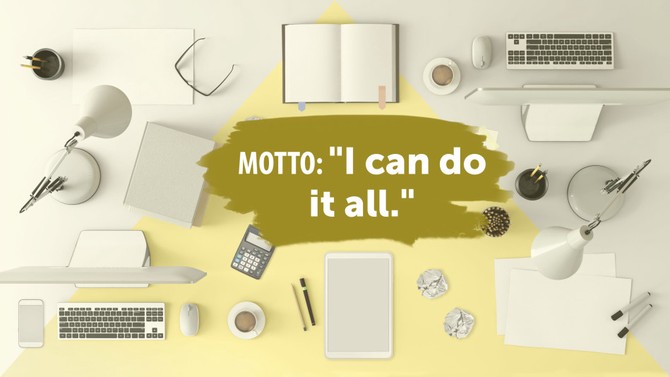
Photo: iStock
Archetype #3: Energetic
SHADOW SIDE OF ENERGETIC: Scattered
BLOCK: Saying no
HAS A HARD TIME LETTING GO OF: Projects, personal and social commitments
People who operate primarily in the Energetic archetype joyfully move through the world at a pace and with an efficacy that make those around them stare in wonder. The Energetic archetype is a physical way of approaching the world; it radiates energy throughout the body, into the limbs. These people have great stores of energy and zeal, which they use to tackle any project or obstacle in their way. They tend to be innovators at work or deeply committed to their hobbies. They’re often do-it-yourselfers, or folks who love projects, learning something new, or trying something different.
The shadow side of the Energetic archetype is that same, vibrant energy but refracted through a crystal. These people are, in one word, Scattered. Despite being passionate and engaging, this type often starts but rarely finishes projects. They say yes to most things, are chronic over-schedulers, and typically run ten minutes late to everything. Their spaces are filled with aspirational to-dos and projects in progress. They often experience guilt as a result of not completing their projects yet cannot maintain focus long enough to complete something before moving on to the next.
The central idea blocking Scattered types is the idea of saying no to things. Because they love to try new hobbies, start new projects, and learn something different, they have a hard time prioritizing because they want to do everything.
Tool for Moving from Scattered Back to Energetic
You suffer from wanting to do it all, so you likely have many aspirational, unfinished projects around the house. Any project that is incomplete is telling you something: either it is not a priority or you are being unrealistic with your time. Releasing the objects related to these projects not only honors the objects themselves so that they can be used and appreciated by someone else but also gives you a second chance—a chance to start anew and decide how you would like to spend your time now that you’re no longer filled with a sense of duty to complete all these half- started projects. It requires self-forgiveness, for sure. But let us remind you that you can still be a good friend, even if you don’t knit that scarf.
For scheduling, mentally step back and consider your top priorities in your work and personal life. This could be anything from quality time with family to training for a triathlon to earning that promotion at work. Write the top three down. Now look at your actual calendar of upcoming events and projects; does the way you spend your time match what you value most? If you see discrepancies, practice saying no to any activity that doesn’t align with how you’ve just stated you would like to spend your time. Moving forward, actually schedule time for the activities and actions that support your top priorities. Even if it’s just a phone call to your best friend, formally setting aside your time will ensure that it doesn’t get filled with something less important that might crop up the day of.
To-do lists are your best friends. Take the time to find the system that works best for you. Practice writing a to-do list each morning or the beginning of the week. This will help you pause to think about the essentials you need to make space for. Everything else is optional, just icing on the cake.
BLOCK: Saying no
HAS A HARD TIME LETTING GO OF: Projects, personal and social commitments
People who operate primarily in the Energetic archetype joyfully move through the world at a pace and with an efficacy that make those around them stare in wonder. The Energetic archetype is a physical way of approaching the world; it radiates energy throughout the body, into the limbs. These people have great stores of energy and zeal, which they use to tackle any project or obstacle in their way. They tend to be innovators at work or deeply committed to their hobbies. They’re often do-it-yourselfers, or folks who love projects, learning something new, or trying something different.
The shadow side of the Energetic archetype is that same, vibrant energy but refracted through a crystal. These people are, in one word, Scattered. Despite being passionate and engaging, this type often starts but rarely finishes projects. They say yes to most things, are chronic over-schedulers, and typically run ten minutes late to everything. Their spaces are filled with aspirational to-dos and projects in progress. They often experience guilt as a result of not completing their projects yet cannot maintain focus long enough to complete something before moving on to the next.
The central idea blocking Scattered types is the idea of saying no to things. Because they love to try new hobbies, start new projects, and learn something different, they have a hard time prioritizing because they want to do everything.
Tool for Moving from Scattered Back to Energetic
You suffer from wanting to do it all, so you likely have many aspirational, unfinished projects around the house. Any project that is incomplete is telling you something: either it is not a priority or you are being unrealistic with your time. Releasing the objects related to these projects not only honors the objects themselves so that they can be used and appreciated by someone else but also gives you a second chance—a chance to start anew and decide how you would like to spend your time now that you’re no longer filled with a sense of duty to complete all these half- started projects. It requires self-forgiveness, for sure. But let us remind you that you can still be a good friend, even if you don’t knit that scarf.
For scheduling, mentally step back and consider your top priorities in your work and personal life. This could be anything from quality time with family to training for a triathlon to earning that promotion at work. Write the top three down. Now look at your actual calendar of upcoming events and projects; does the way you spend your time match what you value most? If you see discrepancies, practice saying no to any activity that doesn’t align with how you’ve just stated you would like to spend your time. Moving forward, actually schedule time for the activities and actions that support your top priorities. Even if it’s just a phone call to your best friend, formally setting aside your time will ensure that it doesn’t get filled with something less important that might crop up the day of.
To-do lists are your best friends. Take the time to find the system that works best for you. Practice writing a to-do list each morning or the beginning of the week. This will help you pause to think about the essentials you need to make space for. Everything else is optional, just icing on the cake.
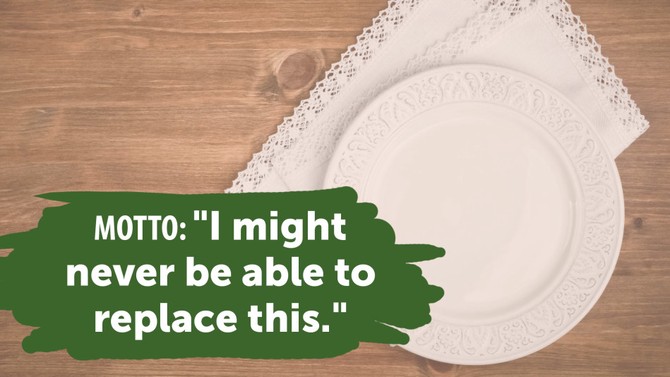
Photo: iStock
Archetype #4: Frugal
SHADOW SIDE OF FRUGAL: Scarcity
BLOCK: Money
HAS A HARD TIME LETTING GO OF: Anything with monetary worth or perceived rarity
People who operate from the Frugal archetype tend to act from a place of mindful self-awareness and contentment. They plan for the future but are rooted in the present moment, viewing their surroundings with clarity. Frugal types have thoughtfully uncovered their most important goals and choose to spend their resources in ways that are aligned with those highest priorities. They thoughtfully eliminate expenses that do not add to their health, joy, or goals for happiness. They prioritize what is most important and use their resources to highlight these priorities. People who operate in the Frugal state are centered and intentional with how they expend their energy.
In the shadow side of Frugal lies Scarcity. Scarcity has little to do with a person’s current state of wealth, because Scarcity dwells in replaying problems from the past or projecting anxieties into the future. People operating from a place of Scarcity feel unstable, ill at ease, and unsure, and they hold on to the items around them in an attempt to quell these fears. They typically rely on outside circumstances to soothe their internal discomfort. This reactionary behavior often stems from some trauma experienced in the past. We find that when our clients are willing to do the work, to sit down and face all the reasons they allow the clutter to accumulate, they have the biggest breakthroughs.
The central idea blocking Scarcity types from releasing items is money. They hold tight to any object that they spent money on, whether expensive or perceived to have high worth, regardless of whether that object is useful or pleasurable.
Tool for Moving from Scarcity Back to Frugal
Come up with a list of at least three practices that have worked in the past to calm and center you in situations of stress.
Examples include:
Going for a walk
Sitting in nature
Dancing to a favorite song
Journaling
Breaking a sweat
Taking twenty device-free minutes to savor a cup of coffee or tea
Calling up a loved one
List these practices in your journal, and plan to utilize them if you’re having trouble with a particular category down the road.
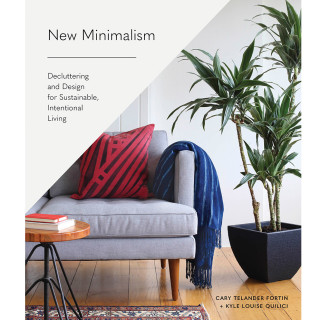
© 2018 by Cary Telander Fortin and Kyle Louise Quilici. All rights reserved. Excerpted from New Minimalism by permission of Sasquatch Books.
BLOCK: Money
HAS A HARD TIME LETTING GO OF: Anything with monetary worth or perceived rarity
People who operate from the Frugal archetype tend to act from a place of mindful self-awareness and contentment. They plan for the future but are rooted in the present moment, viewing their surroundings with clarity. Frugal types have thoughtfully uncovered their most important goals and choose to spend their resources in ways that are aligned with those highest priorities. They thoughtfully eliminate expenses that do not add to their health, joy, or goals for happiness. They prioritize what is most important and use their resources to highlight these priorities. People who operate in the Frugal state are centered and intentional with how they expend their energy.
In the shadow side of Frugal lies Scarcity. Scarcity has little to do with a person’s current state of wealth, because Scarcity dwells in replaying problems from the past or projecting anxieties into the future. People operating from a place of Scarcity feel unstable, ill at ease, and unsure, and they hold on to the items around them in an attempt to quell these fears. They typically rely on outside circumstances to soothe their internal discomfort. This reactionary behavior often stems from some trauma experienced in the past. We find that when our clients are willing to do the work, to sit down and face all the reasons they allow the clutter to accumulate, they have the biggest breakthroughs.
The central idea blocking Scarcity types from releasing items is money. They hold tight to any object that they spent money on, whether expensive or perceived to have high worth, regardless of whether that object is useful or pleasurable.
Tool for Moving from Scarcity Back to Frugal
Come up with a list of at least three practices that have worked in the past to calm and center you in situations of stress.
Examples include:
List these practices in your journal, and plan to utilize them if you’re having trouble with a particular category down the road.

© 2018 by Cary Telander Fortin and Kyle Louise Quilici. All rights reserved. Excerpted from New Minimalism by permission of Sasquatch Books.
Published 01/02/2018

